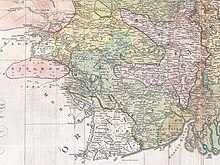Dhalbhum


Dhalbhum was the name given to parganas Supur and Ambikanagar in the Khatra area of present Bankura district in the Indian state of West Bengal.[1] In the course of time, Dhalbhum kingdom was spread over a much wider area, across the western part of adjoining Midnapore district and the eastern and south-eastern parts of Singhbhum district in present-day Jharkhand.[2]
History
According to Colonel Dalton and H.H. Risley, the Dhal zamindar family of Dhalbhum was the members of the primitive Bhumij race, who was selected by the other Bhumij chiefs as their feudal ruler.[3] The zamindars later became Hinduised, and adopted the title 'Dhal' or 'Dhabal Deo'.[4] The family is related to the families of Bishnupur, Raipur, Shyamsundarpur and others.[1] They ruled for about 700 years. A branch of the same family ruled in Chikligarh or Jamboni.[2]
Rankini Devi is established as the family goddess of the Dhalbhum rulers. It is said that human sacrifice was offered to the goddess every year.[2]
References
- ^ a b O’Malley, L.S.S. (1908). Bengal District Gazetteers – Bankura. The Bengal secretariat book depot. p. 166.
- ^ a b c Ghosh, Binoy, Paschim Banger Sanskriti, (in Bengali), part II, 1978 edition, p. 56, Prakash Bhaban
- ^ J, Reid (1912). Final Report on the Survey and Settlement of Pargana Dhalbhum in the District of Singhbhum, 1906 to 1911. Bengal Secretariat Book Departmentôt.
- ^ Commissioner, India Census (1903). Census of India, 1901: India (4 v.). Office of the Superintendent of Government Printing, India.
22°56′46″N 86°45′24″E / 22.9460243°N 86.7568016°E
